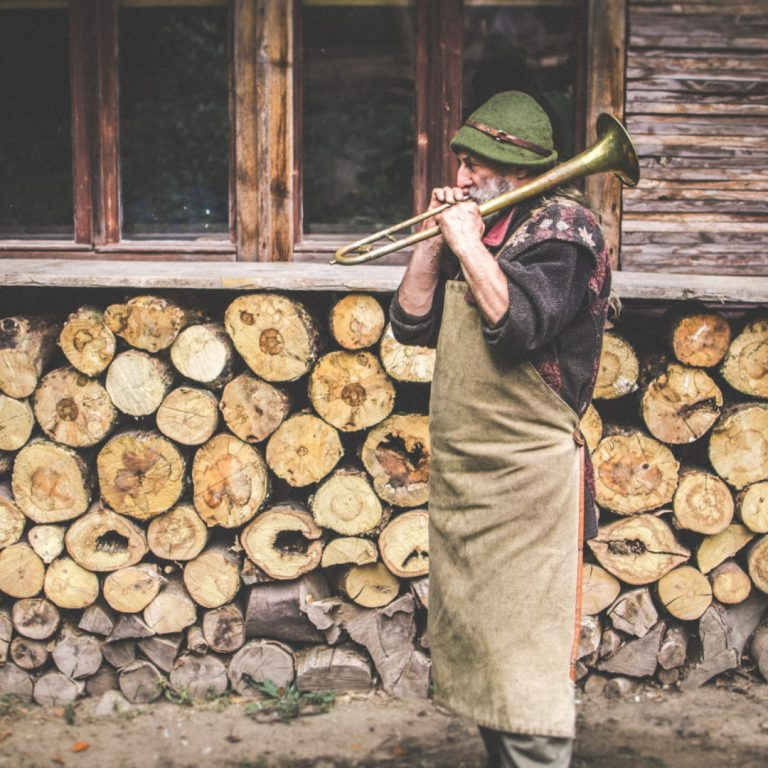The references to Yanko Derevlyanyi on the Internet are as numerous as the roads leading to Yavirnyk Mountain — there are none. People usually come here on foot, and it happens by accident more often than not. It is one of the first places of our expedition. We get here together with our guide Yurii, who brought us from Velykyi Bereznyi town to the mountain, passing by a single village named Ruskyi Mochar. The road is really difficult here. To tell the truth, one can get through the bog on big wheels in summer rather than through snowdrifts. To reach his friend Yanko, Yurii has to fix a snow scoop to his vehicle’s bumper, but even this does not always work out.
Yanko Derevlyanyi looks like a German artist and architect Hundertwasser and creates in the same manner. His house and clothes are reminiscent of Tolkien’s heroes and his lifestyle brings him close to Buddha. Still and all, he is an ordinary inhabitant of Zakarpattia. As a young guy, he served in a construction battalion at Elektrostal plant — the same place where the nuclear bomb was being made as per Kurchatov’s design.
Yanko grew up in a large teachers’ family. He was the youngest child and loved drawing. He was a free man in his own little way. Despite this personal freedom, ten years of letter writing to his future wife, military service and other life circumstances, he got married, brought up two children and lived 35 years with his wife, taking care of his children and supporting their creative urges.
When he returned to Zakarpattia, he was not happy with ordinary life anymore. He actually settled down in Yavirnyk back in the 1970s. There used to be a Soviet-time holiday camp and he was invited to work as an interior decorator there. This camp was upgraded by the Czechs and Slovaks way back in the 1930s.
Yanko’s refuge
Yavirnyk is unique, as it is the only mountain with a stone hut that was permanently inhabited and housed tourists. It was Yanko who was invited to decorate this hut. He was working there and hosting tourists. Yanko came to Yavirnyk in 1974 for the first time and changed a lot there since. He designed and built huts and fireplace with the help of his family and friends. There is a very unusual tourist shelter in the vicinity of Velykyi Bereznyi today that he set up near the very mountain top.
Mountain shelters are quite common in the Czech Republic and Slovakia. One can always stay there, have a rest, cook food, wait out a storm and meet other travelers. They make mountain hiking less dangerous and often save people in bad weather.
— Two girls from Kyiv lost their way in this area one day, — says Maria, Yanko’s daughter. — One of them was a police major. They were on holiday in “Dubovyi Hai” holiday camp and decided to take a walk to Yavirnyk Mountain. A thick mist fell suddenly and they got lost. Some local men they met showed them the way to Yanko’s place. He wasn’t in, but the door was unlocked. The girls came in, got warm, rolled themselves in blankets and fell asleep. Yanko was home back then, but while the girls were wandering in the mist, almost every local inhabitant of Bereznyi settlement called him to say there were two girls who had lost their way. He took his backpack and set off to Yavirnyk. He encountered his night guests when they were coming down from the mountain. The girls understood who he was and thanked him for the place to stay. Yanko climbed the mountain and saw that his visitors had left some money. Next year the girls came to spend their holiday in Yanko’s hut.
Numbers
43 years Yanko has been taking care of Yavirnyk Mountain.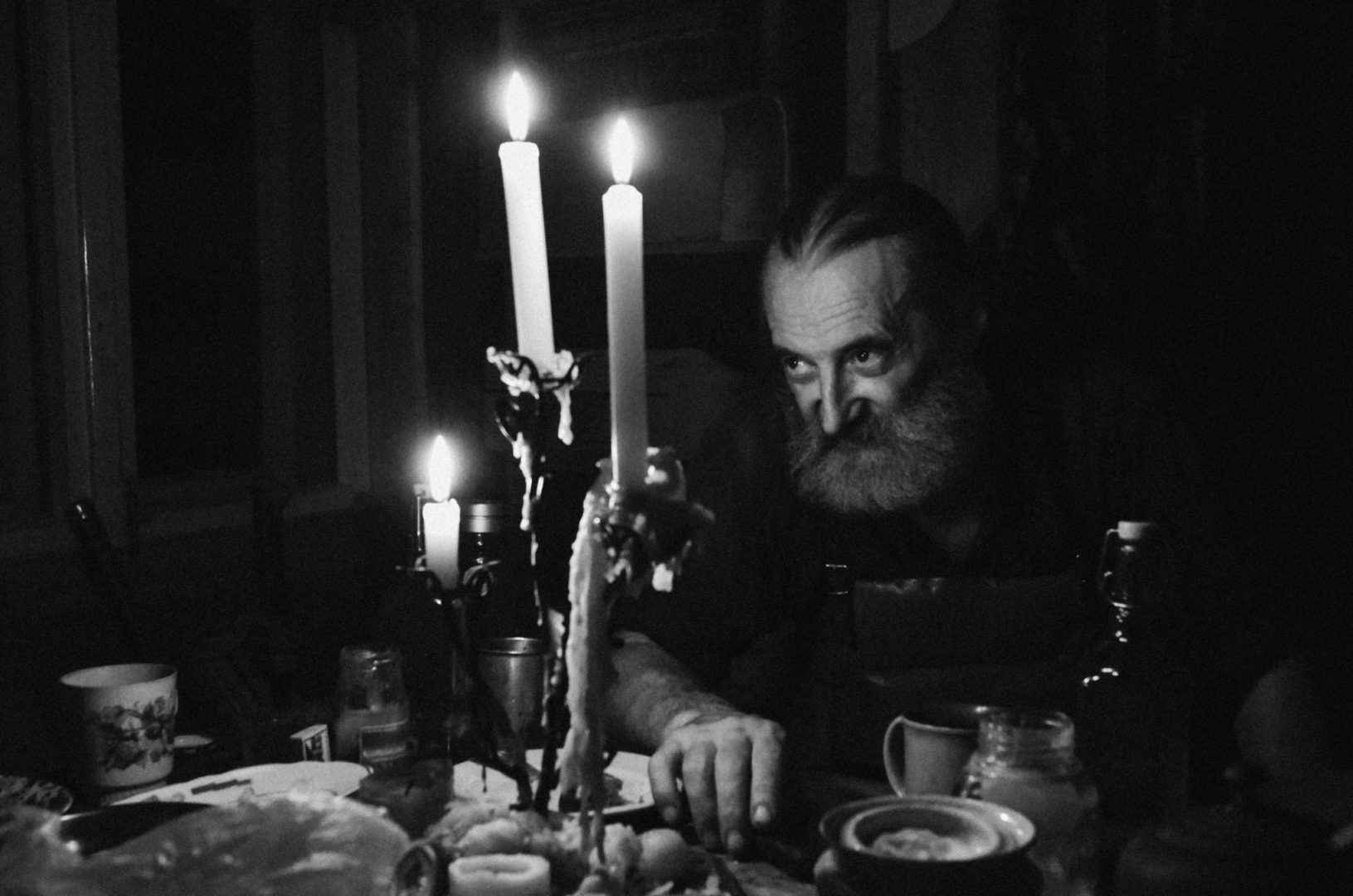
This place is his entire life. People come here to see this unusual place and meet Yanko Derevlyanyi in person. People nicknamed him “Derevlyanyi” (Woodcrafter) when he was working in a workshop in Duboviy Hai. Upon Yavirnyk Mountain one can find tourist routes, blueberries, breathtaking views and Yanko himself. He is not a hermit, as might appear at first sight, but he is quite mysterious. He is a philosopher who knows a good thing about arts, architecture, and life, to be sure. He invented new methods of woodworking: he makes interesting works from one piece, without nails or writhen wood. He gets inspired, reflects, finds solutions and fantasizes. He is much more than expected, but you can discover it only while talking to him; but then you do not want this fascinating conversation to end.
Derevlyanyi’s sculpture and architecture
Yanko is showing us furniture and interior features, houses and architectural concepts, mostly in the pictures. Most of these are scattered around the world.
For example, a large carved rosette — a solar symbol originating from pagan times — is in Denmark now. Ukrainian doctors gave it as a present to their Danish colleagues. The doctor who owns this masterpiece came to visit Derevlyanyi and said this work resembled the sun. Yanko started making this picture in the 1980s. It was not allowed to make such things back then, and he finished it during Ukrainian independence, in 1995.
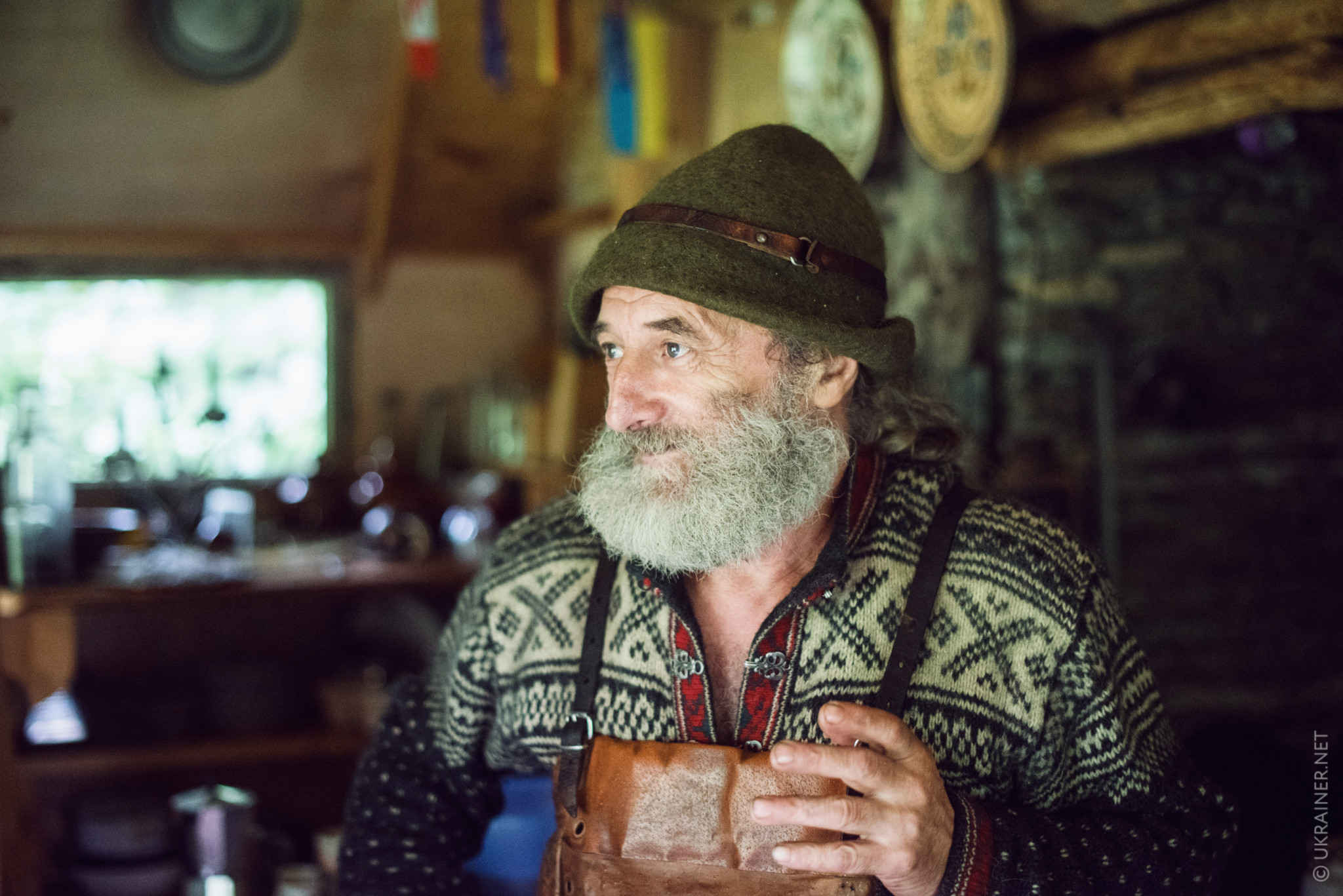
— Happiness is only the moments when you’re doing something that makes sense to you. It’s a never-ending experiment.
Some works are deeply impressive even in the picture. A carved cross, three meters long, was made of an enormous piece of wood Yanko had been “carrying around for 12 years”. Then he carved it. This cross now adorns a small Italian church in Bassano town.
— Celentano lives nearby, you know, — Yanko says with confidence.
He can work with defective material that other craftsmen do not take up. He makes furniture of writhen wood or folded boards. He uses texture, matches ideas and materials and makes natural elements work to the benefit of his handiwork. He works zealously and pays attention to signs and symbols.
There are also wooden bridges in his portfolio: arched bridges and trestle bridges. Sometimes these are the architectural requirements that inspire certain artistic solutions in Yanko’s works — like a “spider” he shows in the picture. It is the main supporting structure for the cover above a 20-meters terrace.
— I made it on those old slopes. I can’t say it’s know-how. Someone must have been making it long before me. But I used my own designs. Gaudi and Calatrava were my best teachers.
Yanko respects these architects a great deal and gains inspiration from them. Antonio Gaudi was a Spanish Catalan architect and artist who designed the most prominent landmarks in Barcelona. He decorated his building with wrought iron towers, out-of-the-box solutions, and decorative ceramics. Not only was he a disrupter of forms, but he also had three-dimensional imagination and could create versatile things, like ornamental casting and furniture design.
Santiago Calatrava is another Spanish architect, author of numerous futuristic structures. His style is a mixture of architecture and sculpture. He created bridges, buildings and road junctions in Europe, the USA and Asia.
Yanko also mentions a Hungarian architect Marcel Breuer but says that people from this region are not very fond of him. Breuer was working in the US and worked wonders with stone and shaped concrete. Yanko describes Breuer’s 20-meters bell tower, and his story is impressive, for Yanko has never been abroad. He only did practical training in Moscow and the Baltic, and once visited former Leningrad (presently — St. Petersburg). Instead, he has pictures of his works from every corner of the world. He just brushes aside a question about whether to would like to go and see Gaudi’s works, saying he saw those works in the pictures his friend had brought him. Yanko cannot stand leaving his beloved Yavirnyk for such a long time. He adores Breuer and made numerous works in his style — for instance, he worked with shaped concrete structures.
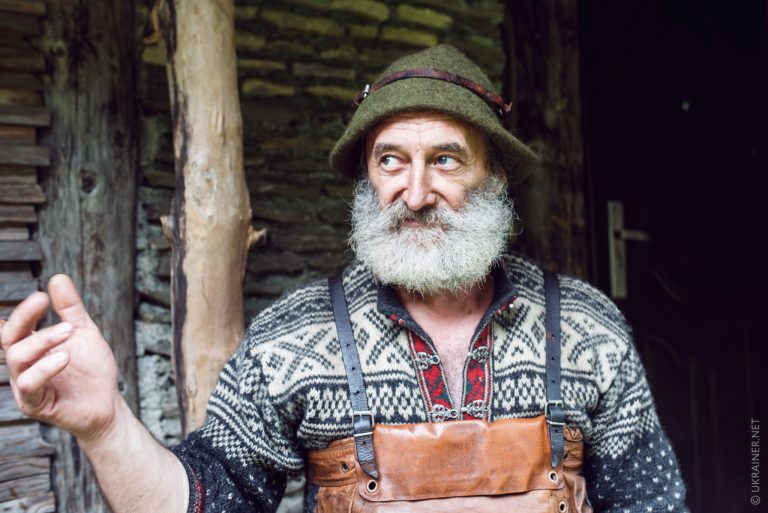
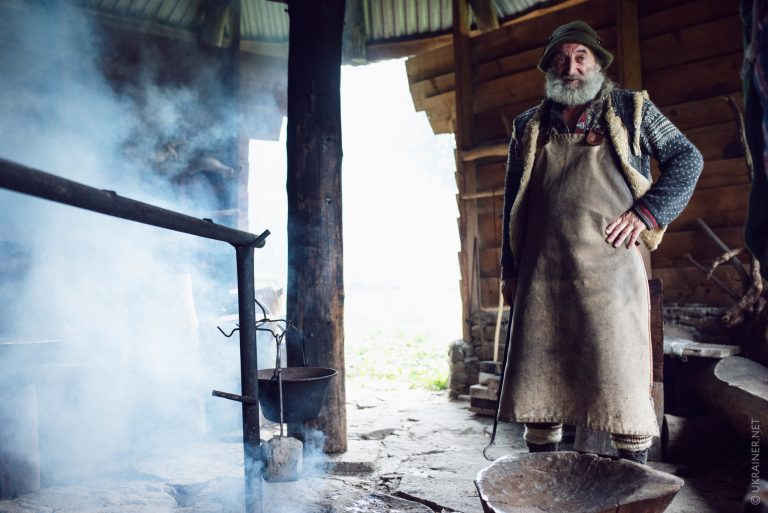
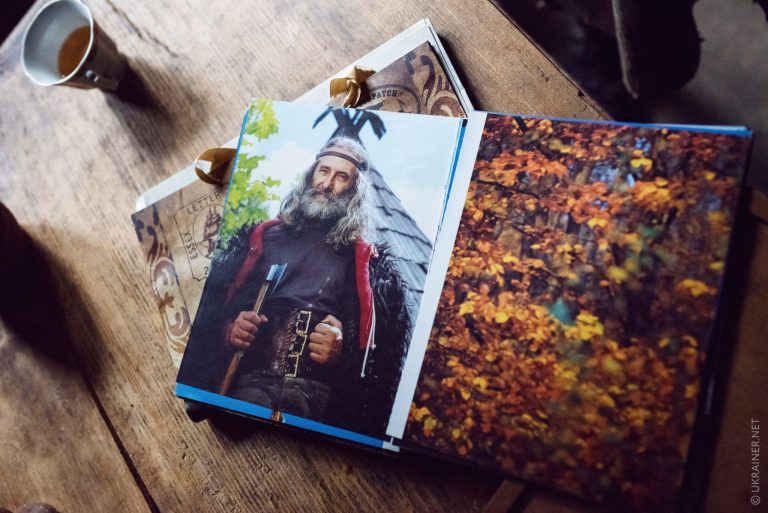
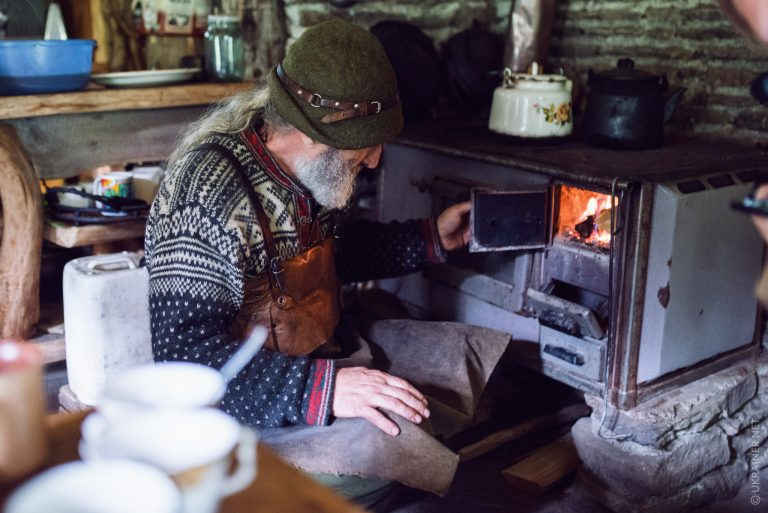
slideshow
Despite his “wooden” nickname, Yanko is fond not only of wood, but also stone, metals and even concrete.
— I learned a lot about concrete in the army. I graduated with a degree of a concrete structure installer. I saw real work and real concrete there. The plant was just awesome. They were making things for space systems. I learn to make lots of things from metal and concrete there. They used top-quality metal, the same as for weapons. Russian general Suvorov said, “The bullet is a mad thing, and only the bayonet knows what it is about.” It means, concrete is mad, and a stick is the most important thing, but no one wants to fiddle with a stick.
Life is rapidly changing in Yavirnyk. Yanko has got a picture with a ski lift which is not there anymore. There used to be an old Czech forestry and a holiday camp designed by an architect Schneida. People from everywhere came there to ski because there were both snow and trail. Now everything is gradually decaying, except for Yanko’s building itself. Despite anything, he keeps improving the area and making it more comfortable for tourists. Now he can host up to 20 people, but there is always room for one more:
— There are several paths leading to the top, and even a passage for cars. Truth must be told, not everyone can drive through it. I can reach the top very quickly, for I know the shortcuts, but tourists must walk for several hours.
The land where Yanko lives now belongs to his friends’ son.
— This kid came to me and said, “Uncle, I want to do it like that…”. He didn’t tell me he took this land to breed horses. I started doing it, drafted a project. It was eight years ago.
After that Yanko’s life in Yavirnyk was not so lonely. Workers who were helping to build guest houses lived there with him once in a while.
There were also several people who took care of livestock. There was a stable at the foot, and there was a horse second to none — he could be a carriage horse, and a saddle horse, and could haul wood too. Then there were rams, sheep, and goats. It was fantastic; saying nothing of Mongolian semi-wild horses…
Yanko’s neighbours
In addition to livestock, there is lots of wildlife in Yavirnyk. It is them, and not people, who are Yanko’s most frequent guests and closest neighbors. One can see a weasel that is used to being among humans. By the way, a weasel is the world smallest predator. Usually, it hunts mice, but can also kill a rabbit twice its size.
— Weasels are rather bold. You can tuck it inside your shirt. They are more or less neat; they are just running around, pushing everything. I even had to move press irons off the shelves, for they can drop them on your head, but their character changes with time. Mice, on the other hand, are very naughty. They eat everything. They come in herds, and if they find food, they destroy everything to the last crumb. Weasel loves muffins; it nibbles through the net and gets inside.
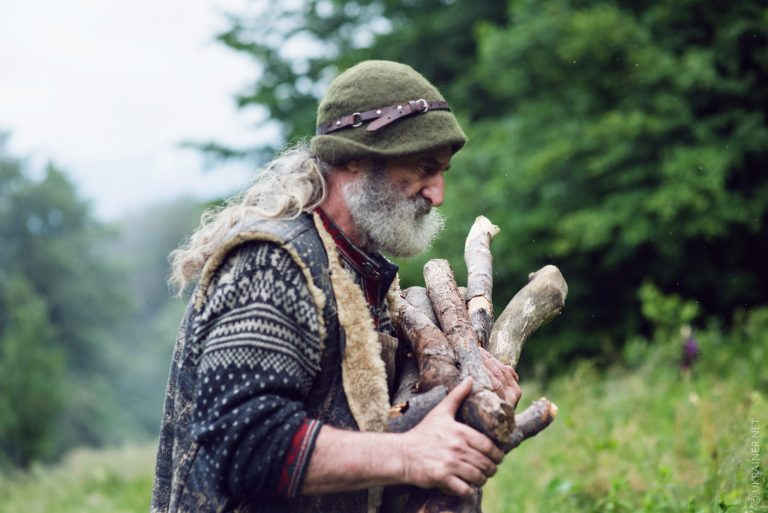
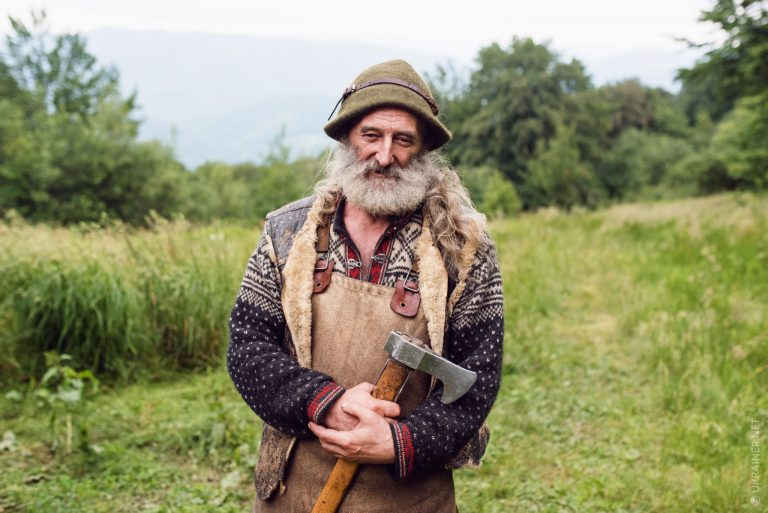
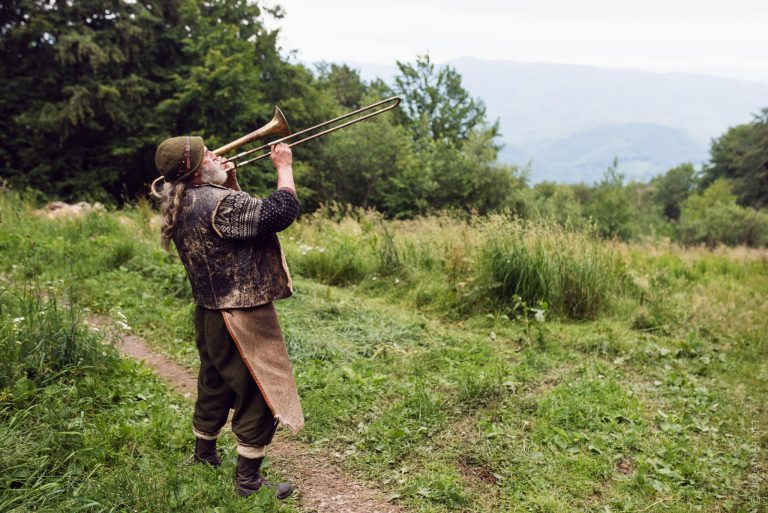
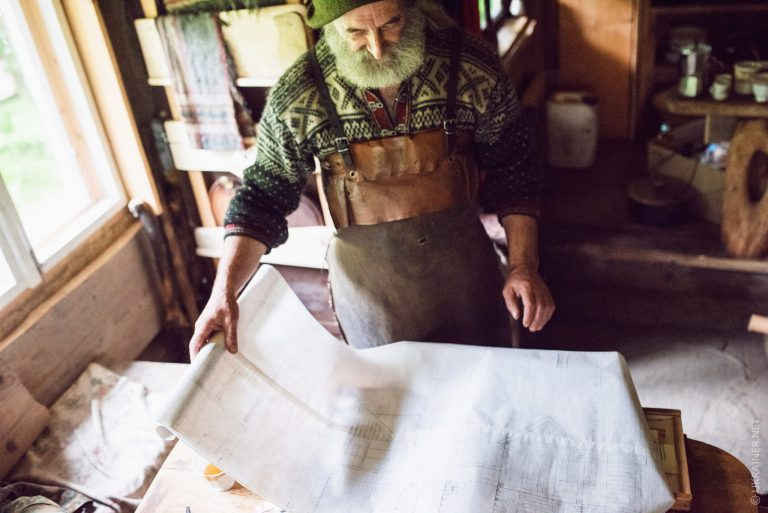
slideshow
Yanko says even cats run wild here, and it is a rare soul that can spend much time in Yavirnyk:
— It must be the voice of one’s heart. You can do it no other way. I put guys on carrying up a ton of wood. They didn’t ask what this wood was for, they just carried it. Years went by, and there were children coming to tell me their father had carried that wood up here.
The climate in Yavirnyk changes and fauna changes along with it.
— The snow used to be so deep here that my dog entered the house thought the second-floor window, — recollects Yanko. — There has been less and less snow in the last three years, and no one will know soon what real winter is like. I saw deer when I was still a kid, and now there are none. You could see a stag with huge horns on his head, and then he’s off in several huge leaps. There are still some bores. I saw once a buck courting a roe. I was about fourteen or fifteen years old, he ran out of the woods and stood in front of me. І watched a buck and a roe’s foreplay, when the buck kneeled with his head lowered to the ground, cajoling the roe. It lasted some half an hour.
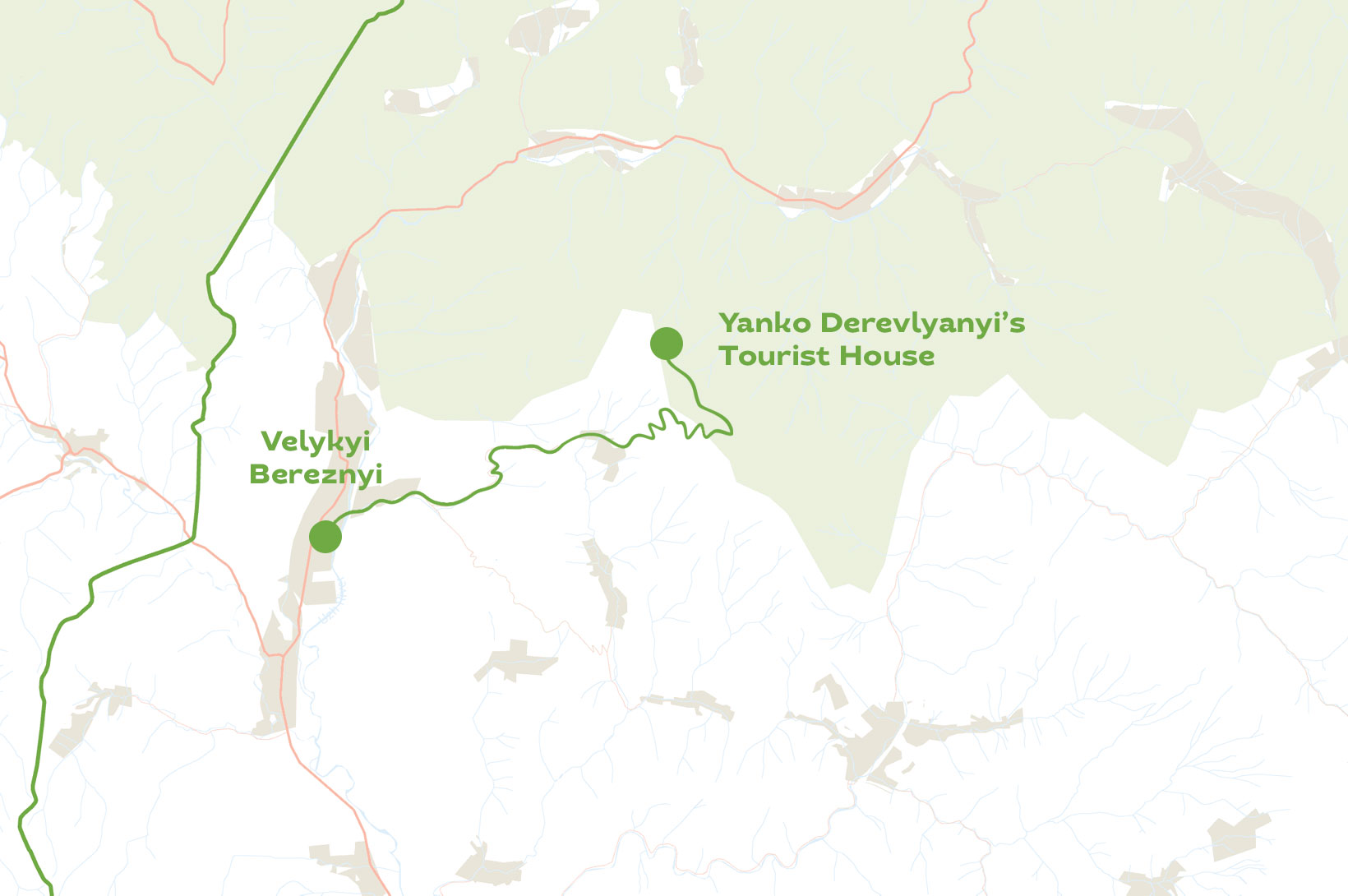
There is a water pool at the foot of Yavirnyk Mountain, and wild bores, foxes and wolves still come there. However, animals become extinct, and not only due to climate changes. Yavirnyk still is a hunting area, despite its reserve status. People from Bereznyi, Sil, and Zabrid come here to hunt.
Yanko does not keep count of his guests, but he is always happy to welcome them. He lives 1017 meters above sea level, and even people with children often come here. Yanko treats them to his signature dishes, tells stories, brews special tea from local herbs and gives a tour of the surroundings. Yavirnyk comes to life thanks to him. Derevlyanyi does not hunt his neighbors, and they leave him alone, aside from naughty mice. Yanko observes, takes sketches and shares his stories with anyone who comes across.

